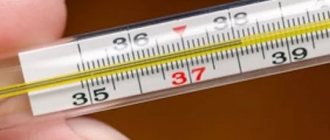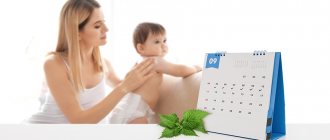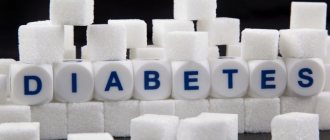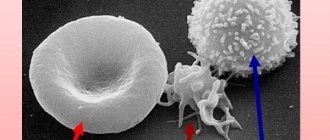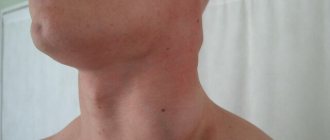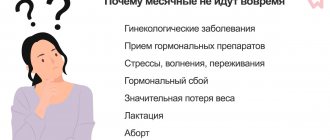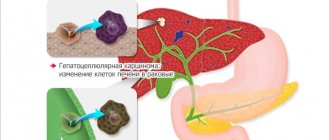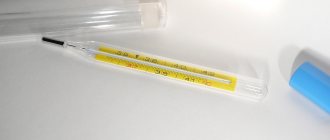It is not uncommon for a child to have a temperature of 38 without symptoms. A sharp jump to high levels occurs in infants, one-year-old children, and children who go to kindergarten or school. This happens due to a violation of the body’s thermoregulation. Most often, the symptom occurs with colds. However, in infants the temperature can rise and last from three to seven days for other reasons.
Baby has a fever
How to correctly measure a child's temperature?
What to do if you notice that your child has a fever? First of all, you need to measure it accurately. Many parents rely on subjective sensations by placing their lips on the child’s forehead or face, so they roughly guess how many degrees the temperature is. It is not right.
You need to know exactly how high the baby's temperature is. To correctly measure body temperature, the thermometer must be placed in the armpit, pressing firmly with your hand. About three minutes is enough time.
It should be remembered that in a newborn baby, a temperature of up to 37.50C is considered normal; you should not try to reduce it. In a healthy child, an increase in body temperature can be observed immediately after eating, sleeping, or physical or emotional stress. If such an increase in temperature is not accompanied by other complaints, then there is no point in drawing negative conclusions.
Tips for parents on caring for a child with a high fever
At the end of the article, we want to give some recommendations on caring for a child with a high temperature:
- food. Do not force anyone to eat when they have a fever. Offer a snack when it subsides, light soup or porridge. Eliminate meat, fatty, sweet;
- drink. There should be a lot of liquid. Constantly offer your son or daughter a little drink. At temperatures up to 40°C, it is not so much scary as dehydration of the body;
- cloth. There should be a minimum. Do not wrap yourself up or make you sweat, this puts a lot of stress on the heart muscle. At high temperatures, you need to undress and uncover the child, allowing excess heat to get rid of through the skin;
- if your feet are cold. Check the temperature of your child's feet by touch. If they are cold at high temperatures, then it is necessary to massage them;
- rubdown Do not use alcohol-containing liquids or vinegar for compresses. Just water at room temperature is enough;
- room. Ventilate the room where the patient is located at least 3 times a day. Carry out wet cleaning daily.
What parents should do if their child has a high temperature
If the temperature is not higher than 38.00C, the baby does not have chills and there is no severe concomitant pathology, for example, heart disease, pathology of the nervous system, convulsive syndrome, and the limbs are warm, then such a fever should not be brought down. Every half hour you should measure your body temperature, and if it rises above 38.50C, then call a doctor at home and give the baby antipyretics (suppositories, syrup or antibiotic).
Before the doctor arrives, parents should provide first aid to the baby. The child should be put to bed without covering him, even if he has severe chills. Provide access to fresh air and give the baby plenty of water. Doctors allow wiping the baby's body with cool water or making cold compresses.
You should not wipe the child’s body and limbs with alcohol or vinegar when the body temperature is elevated, especially if the baby has cold feet. The toxic substances of these solutions are absorbed into the baby’s body through the skin. It is also impossible to cover a feverish child, no matter how severe the chill. It is also not worth treating the child yourself, including giving antibiotics. Any medications, including antipyretics, should be prescribed by a doctor after the cause of the temperature has been established!
Why does a child have cold legs and arms when he has a fever?
Why does a child have cold feet at a temperature of 39.00C? Why are the legs and arms cold, while the rest of the body is “burning” and may even be red? The presence of such symptoms is often associated with a sharp spasm of the small vessels of the limb. This is called "pale fever." This temperature drops very hard and requires the addition of antispasmodic drugs to therapy.
First aid will be to warm cold feet. The limbs can be immersed in hot water or rubbed with mustard (folk remedies are effective in these cases). No antipyretic drugs will help as long as the baby has cold hands and feet.
How to help at home
If a child has a temperature of 38 - how to treat
The famous children's doctor and candidate of medical sciences, Evgeniy Komarovsky, draws the attention of parents to the fact that the temperature can rise for individual reasons. There are no universal remedies that will suit every child; it is worth taking into account all the characteristics of a particular baby.
Your doctor suggests the following steps for fever without symptoms:
- Give plenty of fluids,
- Provide cool air in the room,
- Wipe the baby's body with wet lotions or make compresses.
If you apply compresses to the forehead and calf area of the leg, this will help reduce the temperature
Important! In cases where there is no infection, such manipulations will help in 99.9% of cases the body independently overcome the increase in temperature.
An ambulance, regardless of the severity of the fever, should be called if:
- The child started having seizures
- The temperature does not decrease with the administration of an antipyretic,
- Indicators of 39 and above are maintained for more than 15-20 minutes.
- The baby's breathing is difficult. This does not apply to mild wheezing and coughing with ARVI.
- The baby turns pale, behaves lethargically, loses consciousness, and has cold extremities.
Is it necessary to lower the temperature?
Indicators up to 38.4 are considered insignificant and do not require knocking down. Even if all the above symptoms are present, pediatricians strongly recommend not to carry out any manipulations.
Additional Information. In an absolutely healthy child, the temperature may rise when digesting heavy food, as well as when reacting to antihistamines.
The consequences of knocking down low indicators can be disastrous: various functions of the body will be disrupted, and immunity will decrease. The rectal method of measurement can indicate a temperature one degree higher than the oral method.
Should I give an antipyretic?
All medications that reduce fever must be strictly discussed with the treating pediatrician. In the modern world there is an abundance of medicines, so each drug is prescribed individually. Uncontrolled use of certain medications suppresses the immune system.
Antipyretics for children
What is strictly forbidden to do:
- Ventilate the room where the child is located,
- Rub the body with alcohol or tinctures,
- Use mustard plasters
- Give Aspirin or Analgin,
- Use antibacterial drugs
- Applying ice or something cold to the body will cause severe vasospasm,
- Wrap up the child even more tightly,
- Carry out inhalations.
Important! If the baby has a fever and cold extremities, this indicates white fever and damage to the nervous system. In this case, you should first rub your feet and hands until warm, and only then give antipyretics. If this is not done, the medicine will not be absorbed. Be sure to call an ambulance.
Temperature readings in a child that should be feared do not appear on their own. They always have a reason (overheating, cooling, infection), and there is an accompanying symptom. If you monitor your baby’s behavior and seek medical help on time, there will be no questions or complications.
Diseases and conditions that may be accompanied by elevated body temperature
Stomach ache, red throat, sore throat, headache, cough, frequent urination, snot, cramps - these are just some of the reasons that cause fever and chills.
The causes of elevated temperature in a child are usually the following.
Sore throat or pharyngitis (red throat). This is a viral infection. An increase in body temperature in this case indicates an infectious cause of the disease. If the temperature rises sharply to 39.00C or higher from the first days of illness, it is accompanied by a runny nose, snot, cough, sneezing, the throat begins to hurt and is red, most likely the baby has a viral infection and intoxication develops (a condition that appears when poisoned by toxins viruses or bacteria). This type of sore throat is less dangerous than herpetic sore throat.
Today, herpetic sore throat is common. With tonsillitis (tonsillitis), an increase in temperature is often accompanied by lethargy, drowsiness, pallor and nausea; the stomach may hurt or a headache may appear, which indicates that the child’s body is poisoned by bacterial toxins. The throat does not hurt much and is slightly red. Sore throat must be differentiated from diphtheria, a serious fatal disease.
With diphtheria, the throat does not hurt, it is not red, and the temperature rises. If you have all of the above symptoms, you should immediately contact your pediatrician. The temperature will persist until an antibiotic is prescribed. Antipyretics should be given immediately, without waiting for high numbers, because sore throat is quite dangerous.
The presence of symptoms such as abdominal pain, combined with high body temperature, may indicate any inflammatory processes in the child’s abdominal cavity, including poisoning. When a child has abdominal pain, consultation with a surgeon is mandatory. Starting from appendicitis, pancreatitis (inflammation of the pancreas), peritonitis (inflammation of the peritoneum), ending with pyelonephritis (inflammation of the kidney tissue). The temperature rises to 39 and above, chills appear. If your stomach hurts and you experience frequent urination, you may suspect a genitourinary infection.
Fever accompanied by loose stools (diarrhea) may indicate that there is an intestinal infection in the body. The manifestation of these symptoms may be combined with vomiting and abdominal complaints. Diarrhea can also occur due to poisoning. If your stomach hurts, helminthic infestation cannot be ruled out. How many days the fever will persist depends on the severity of the disease. In case of severe poisoning with toxins, even hallucinations may occur against the background of dehydration of the body.
A set of symptoms, such as headache and fever, may indicate intoxication of the body (poisoning with toxins) or a severe infection of the nervous system (meningitis). In the latter case, fever and headache are combined with vomiting. Antibiotic and detoxification agents are required in this case. Headache, fever and convulsions can be a serious sign of a tumor process.
Fever and frequent urination. As a rule, such a complaint is a manifestation of an inflammatory process in the bladder. Urination will be painful. The temperature can rise to 38.00C. If the inflammatory process spreads to the kidneys, pyelo- or glomerulonephritis develops, the temperature rises to high numbers (above 38.00C), the stomach and back hurt, and frequent urination begins. When poisoned by bacterial toxins, vomiting, weakness and drowsiness occur. In these cases, doctors will definitely prescribe an antibiotic, otherwise the fever may last a long time.
Fever accompanied by a runny or stuffy nose. An increase in body temperature and runny nose is usually a manifestation of an acute respiratory viral infection. If there is prolonged nasal congestion and a small amount of snot, a decreased sense of smell, headache and an increase in body temperature to low numbers, up to about 37.50, then sinusitis, inflammation of the paranasal sinuses should be suspected, and to treat such a disease you should immediately start taking an antibiotic.
An increase in body temperature with stomatitis can be higher than 39.00C. This condition usually occurs with severe viral or bacterial stomatitis. The infection causes a severe inflammatory process in the oral mucosa. With fungal stomatitis, the temperature may not rise. In this case, an antibiotic is not needed; the prescription of antifungal drugs will be enough, and for bacterial stomatitis, an antibiotic is required. If you have stomatitis, it is also important to consult a doctor promptly.
High temperature and cough. The first thing you might think of is pneumonia. Yes, pneumonia is one of the most common causes of this symptom complex. Today, due to the aggressiveness of infections, pneumonia is very dangerous due to complications. Cough with pneumonia is frequent, at the beginning of the disease it is dry, then wet. The temperature is above 39 degrees, headache, nausea, weakness, and snot appear. The body is gradually poisoned by infection. If a cough appears against the background of a low temperature and hurts in the sternum area, then bronchitis most likely develops. A cough can be combined with an increase in temperature even in the presence of a foreign body in the bronchi. Snot in a child usually appears both with pneumonia and bronchitis.
In case of any of these conditions, you should immediately consult a doctor, since any illness is dangerous for a child!
Reasons why body temperature may rise without other symptoms may include:
- Overheating of the child. A common mistake young mothers make is that they always try to wrap up their baby. In a child under one year old, thermoregulation processes are somewhat atypical, and any overheating can cause a sharp increase in body temperature above 39 degrees. In such a situation, the first thing to do is undress the baby. For older children, fever may be caused by prolonged exposure to the sun - this can lead to heatstroke. First aid is to cool the baby, for example, apply a cold compress to the forehead, move the baby to the shade, or give the baby cold water to drink.
- Severe psycho-emotional trauma. Many parents do not associate an increase in their child’s temperature, for example, with exams or a quarrel with peers. But the nervous system in children can react to such circumstances in its own way, in some cases the child’s temperature rises.
- Teething. A common reason for an increase in body temperature occurs against the background of the child’s complete well-being. When teething, you may notice a number of symptoms - the baby has become more whiny and capricious, the stomach is swollen, appetite is decreased, and the surface of the gums is slightly swollen or reddened. Parents at these moments need to be especially attentive to the child, since during teething the baby’s local immunity decreases, which increases the likelihood of contracting an infection, bronchitis or sore throat may develop, and the throat may become red. Therefore, the child’s feet should always be warm. A high temperature during teething can last for several days, all of the above can be accompanied by diarrhea, but this will not indicate poisoning, just as a red throat, cough, and snot will not be a sign of bronchitis. The throat usually does not hurt during teething, even if there is a cough. Many mothers immediately start giving their baby antibiotics, but this is not worth doing. You can give antipyretics, but it is better to consult a doctor for advice. Sometimes during teething there is frequent urination.
- Preventive vaccinations. An increase in body temperature in children after vaccinations is considered a normal reaction. It can be observed in the first three days after the injection; after some vaccines, for example, against measles, rubella and mumps, elevated body temperature can last up to 15 days. It is necessary to reduce the temperature after vaccination.
Causes of asymptomatic “jump” in temperature in children
There are three factors of infectious and non-infectious origin that become the main culprits that cause high fever in children without other clinical manifestations.
- Bacteria and viruses - quite often at the very beginning of infection with pathogenic pathogens, one of the symptoms is present - high body temperature.
- Teething - deviations from the norm of the thermal indicator in this case are part of the physiological characteristics of the child’s body.
- Thermal overheating - gives an asymptomatic increase in temperature, and this can happen not necessarily in hot weather, but also after a winter walk.
The temperature more often jumps without accompanying symptoms in very young children (0-3 years), this is due to the following points:
- In infants, thermoregulation functions are weak, which often leads to overheating of the body, for example, if the baby cried for a long time or was dressed warmly;
- clinical signs of some similar pathologies in children and adults may differ in the nature of manifestation and sequence of occurrence;
- in pediatrics there are special infectious diseases that tend to manifest themselves especially in infancy and early childhood (1-3 years);
- with new infections that the body of a small child encounters for the first time, due to an imperfect immune system, a temperature reaction may occur;
- small children, especially if they are newborns, are not yet able to make it clear that they are worried about the tummy or a headache, so the pathogenesis clinic itself is present, but only one part of it is visible to parents - the symptom of high temperature;
- By the age of 3, children should have a full set of baby teeth, and their eruption is often accompanied by occasional exacerbations of fever.
Bacteria and viruses are the culprits of fever without symptoms
It is worth noting that in most cases, with diseases of a bacterial and viral nature, in addition to high temperature, there are symptoms, but parents do not notice them. A pediatrician will usually, after the first examination, easily identify a particular infectious disease in a child and give basic recommendations for therapy.
Throat diseases
All acute infections that affect the throat cause inflammation and, accordingly, an increase in temperature. The problem is that babies and very young children cannot tell their parents about painful discomfort in the throat, and it is very difficult to look at the condition of the baby’s pharyngeal mucosa. The most common throat diseases in childhood are:
- pharyngitis caused by rhinovirus infection: the inflammatory focus causes a fever in the child, and when examining the condition of the throat, tissue hyperemia, the presence of small pimples and ulcers are revealed;
- herpetic tonsillitis , provoked by Coxsackie viruses: the infection is accompanied by high temperature and damage to the throat - inflammation and redness, blistering formations on the palatine arches, tonsils and the back surface of the larynx;
- acute tonsillitis (tonsillitis) : the source of the disease is adenoviruses, streptococci and staphylococci; the disease does not affect infants, but often occurs in children of preschool and primary school age; the inflammatory process occurs with high fever, a painful sensation in the throat, while whitish streaks and purulent plugs are visible on the tonsils.
Each type of respiratory infection requires specific treatment, for example, when infected with a sore throat, drugs with antibiotics are necessarily prescribed, but for herpetic tonsillitis, which is caused by a specific type of virus, you will need to use a specific antiviral agent in combination with antiseptic throat procedures. As for acute pharyngitis, it comes in different types - viral and bacterial etiology, therefore, for each particular case there will be its own therapy, which can only be selected by a specialist. It is allowed to help lower the temperature with medication only at very high values – from 38.5 degrees and above.
Oral infections
In children, there are mainly two infections that affect the mucous membrane of the oral cavity, due to which the temperature can rise to 38 degrees or higher, these are:
- stomatitis : characteristic signs of inflammation in the mouth are the presence of whitish pinpoint ulcerations and serous blisters on the inner surface of the lips, mucous membranes of the cheeks, palate, gums and tongue, as well as decreased appetite and refusal to eat, increased secretion of saliva;
- thrush: this is a fungal disease of the oral cavity that develops in infancy, and the most striking symptom is the formation of a cheesy coating on the mucous membrane of the baby’s cheeks and tongue; in addition, the child has poor appetite.
First aid measures: rinsing the mouth with antibacterial solutions - chamomile or sage infusion, furatsilin solution.
The child’s menu should consist of the most pureed and liquid dishes possible, while excluding juices, fruits, salty foods and other foods that can cause severe painful discomfort in the child’s mouth. Inflammation of the ear - otitis media
Acute otitis is always accompanied by excruciating pain in the ear and high temperature (38.5-39). An adult child will definitely tell his parents about the painful syndrome. But with small children of the infancy period the situation is more complicated. The fact that the baby is worried about the ear, which is inflamed and gives rise to fever, can be determined by three signs:
- the child is very capricious and sleeps poorly;
- the baby often pulls his hands towards the sore ear;
- The child lost his appetite.
In order to eliminate the infectious-inflammatory focus, the pediatric ENT doctor will prescribe a medicine with an antibiotic in liquid form for instillation in the ears or an ointment composition with an anti-inflammatory effect.
Roseola infantile
A common herpesvirus disease that affects 70% of children under two years of age. The initial clinical sign of infection is fever. The temperature jumps to 39-40 degrees and persists for about 5 days. After a persistent period of heat, the temperature values decrease, and following their decrease, pink rashes appear throughout the body. Dermatological symptoms are safe and disappear on their own without drug intervention after a couple of days.
During a febrile period, it is necessary to provide the child with rest and bed rest, and also give large quantities of fluids. As antipyretic therapy, the doctor will prescribe safe medications in the form of suppositories, tablets or syrup based on ibuprofen or paracetamol.
Pathogenesis in the urinary system
Microbial inflammatory diseases of the genitourinary system, both in adults and children, very often occur practically asymptomatically, but with periodic increases in body temperature. To diagnose an infectious process in the genitourinary organs, the child’s urine should be submitted to the laboratory for a general examination. If the diagnosis is confirmed - the presence of bacteria in the urine, a specialist will prescribe antibiotic therapy.
Teething
A fever in a child that appears without other symptoms is often associated with the eruption of the first teeth. The growth process of baby teeth begins at 6-8 months and continues until 2.5-3 years. The fact that it was teething that caused the high temperature can be suspected by the baby’s profuse drooling, increased capriciousness of the child and poor appetite. But these signs are only a secondary indicator that the temperature has risen precisely because of the growing tooth. A febrile symptom can be more confidently associated with the eruption of baby teeth if:
- the baby pulls fists, toys and other objects into the mouth, pressing them tightly with his jaws (“gnaws”) - in a similar way the child scratches itchy gums;
- your baby’s age corresponds to the period of teething – from 6 months to 3 years;
- the mercury column of the thermometer does not rise above 38 degrees;
- when examining the mouth, the parents discovered swelling and slight redness of the gums or had already noticed a tooth breaking through;
- the last time he was teething, the child had a similar condition - the body temperature was higher than normal;
- after the tooth erupted, which happens after about three days, the temperature immediately returned to normal.
Basic recommendations
- You can relieve discomfort in your baby’s gums with the help of gels specially designed for small children during the teething period.
- A special silicone ring filled with water helps to speed up the teething process and relieve pain. It is better to cool it and then give it to the baby.
- In the children's room it is necessary to maintain the air temperature within 20 degrees. Therefore, ventilate more often, but just make sure that at this moment the baby is in another room.
- If a child has a fever, he needs to organize sufficient intake of warm fluids - give him water and children's herbal teas to drink more often between main feedings.
- When, after measuring your body temperature, the thermometer shows 37.3 or higher, you cannot walk outside or swim.
- If the baby has a strong fever due to teething, and the body heat index has exceeded the 38 degree division, you need to give him an antipyretic drug from the children's series. It is advisable to use suppositories based on paracetamol or nurofen, they will act faster (relieve fever, pain) and will not have a negative effect on the stomach.
Thermal overheating
In young children, thermoregulation processes do not yet work correctly enough, and only after 8 years will the child’s heat exchange function at the required rhythm. Therefore, before this age, care should be taken to prevent hyperthermia. A very common situation in infants and young children is a rise in temperature due to overheating. Moreover, problems with heat transfer can occur in a child not only on a hot summer day, but also after a winter walk if the mother wraps the baby up too much. What measures should be taken if overheating does occur, and the child’s temperature rises greatly, he becomes inactive, whiny and drowsy?
- In case of thermal overheating, which occurred due to hot weather, you should immediately take the child indoors, or, in extreme cases, to a shaded place. Wash your baby with cool water and give him water more often.
- In case of hyperthermia, it is necessary to undress the baby as much as possible so that nothing interferes with the body’s natural way of exchanging heat. The room at the time of taking air baths should not be stuffy and warm. The optimal air temperature in a children's room is no more than 20-22 degrees.
- It is good to normalize the temperature of the body by wiping it with cool water. To do this, you will need a bowl of water (32-35 degrees) and a baby washcloth. After soaking the washcloth in cool water, first wipe the baby’s face, then the arms, armpits, neck, and then cool the legs, especially the groin area, in the same way.
- Throughout the day, it is extremely important to give your child as much liquid as possible; it should be lukewarm. As a drink, it is better to limit yourself to pure water, compote or fruit drink.
In the event that overheating actually contributed to the increase in temperature, thermoregulation after using the above methods will be restored within about 1 hour without the help of any medications with antipyretic properties. If there is no antipyretic effect, the cause may be more serious, so call a doctor immediately!
How to reduce the temperature? Traditional and folk remedies
Treating a child without consulting a doctor is fraught with dire consequences, so any treatment should begin with a visit to a specialist. First aid, of course, can be provided by parents, but the help of a doctor will be more effective. Today, WHO experts have approved the treatment of fever in children with antipyretics such as paracetamol and ibpurofen, the dosage forms of which are suspensions, suppositories, and tablets.
The doctor decides how long and in what dosage the drug should be used. It is not allowed to use "Analgin" and "Aspirin", because after these drugs serious complications can occur, for example, a child may develop a headache.
For the smallest children, rectal suppositories and suppositories are a convenient form of the drug, especially when the body temperature rises at night or chills begin. Suppositories are fast-acting medications, are well absorbed into the bloodstream and cause fewer complications. If a child experiences convulsions or vomiting due to fever, suppositories are an ideal antipyretic option. Rectal suppositories are also convenient for treating disabled children.
For older children, suspensions or syrups are recommended. It is better to use products without dyes and fragrances to reduce the likelihood of an allergic reaction to the drug. Any antipyretic drugs should be taken no more than once every 5-6 hours, be it syrup or suppositories.
Folk remedies that will help relieve fever, especially when there are chills, are made from St. John's wort, chamomile and yarrow. Infusions and compresses are made from these herbs.
Possible complications
When body temperature rises in children, interferon is produced in their bodies. A substance whose action is directed against viruses and bacteria. Elevated body temperature also prevents the proliferation of pathogenic microflora and promotes the death of microbes.
In exceptional cases, it should be knocked down immediately:
- people with disorders of the cardiovascular system;
- patients who have been diagnosed with pulmonary pathologies;
- elderly people;
- patients with weak immunity.
It is also recommended to bring down high temperatures immediately for people with neuropsychiatric disorders.
Lack of timely assistance will lead to serious complications for the child:
| Name | Description |
| Exhaustion of the body | With hyperthermia, metabolic processes proceed faster and more glucose is consumed. Considering that the baby refuses to eat, the body begins to use internal reserves. First it breaks down glucose, then fats, which provokes acetone syndrome. Its characteristic symptoms are diarrhea and vomiting. |
| Dehydration | A high fever in a child causes rapid fluid loss. His skin becomes less elastic, hot and dry. Acetonemia accelerates the dehydration process. Fluid leaves the child's body during diarrhea and vomiting. |
| Vascular and cardiac disorders | Against the background of hyperthermia, the heart rate increases. Dehydration leads to increased blood viscosity. The load on the cardiovascular system increases. |
| Convulsions | A complication of high fever in children is convulsive syndrome. |
A temperature of 38° without symptoms in a child under one year of age or more requires qualified assistance from a pediatrician, since the little body is still weak. There remains a high risk of serious complications.
Why is fever dangerous for children? The appearance of seizures
The most dangerous complication of fever for a child is convulsions, they are also called febrile.
The reasons why convulsions occur due to fever can be different:
- difficult childbirth;
- traumatic brain injuries;
- intoxication of the nervous system;
- poisoning by bacterial toxins.
Seizures may manifest as:
- twitching of individual muscle groups;
- throwing back the head;
- eye rolling;
- fading;
- holding or stopping the child's breathing.
It is not always known how long the convulsions last, so you need to urgently call an ambulance. With severe convulsions, lasting more than 20 minutes, the child’s jaws sometimes clench. Do not squeeze them with your finger or spoon, otherwise you may harm the baby. If the seizures have stopped before the doctors arrive, then try to assess the baby’s condition yourself: what kind of breathing he has, how he reacts to the surrounding space.
If the child’s condition is normal, you can give him antipyretic drugs, it is better to put candles, but if the child’s breathing has stopped, then artificial respiration should be urgently performed. If the convulsions lasted less than 10 seconds and occurred no more than once, there is no need to worry. Take care of your children.
Author: Anastasia Kachur, pediatrician
When to see a doctor
If the child does not develop pronounced symptoms and the low temperature lasts for 3-4 days, there is no reason to worry.
Rash and fever in a child
If the thermometer does not decrease for three days, but rises up to a critical point, you should not hesitate, you should call an ambulance and undergo a pediatric examination.
Additional Information. Sometimes the temperature rises due to the baby being tightly wrapped. The baby cannot get out of the warm blanket on its own, so overheating often occurs.
Why does the temperature rise
In children, especially infants, thermoregulation is still quite weak. Therefore, a sharp increase in a child’s temperature to 39 degrees often occurs. But such meanings in some situations are more likely a positive phenomenon than a negative one. That's why:
- At this temperature, the process of reproduction of pathogenic microorganisms is sharply slowed down. In turn, the infection gradually spreads throughout the child’s body.
- The body’s protective functions are activated—cells of the immune system actively absorb microorganisms, and the amount of antibodies in the blood increases.
A sharp increase in temperature in a child (up to 39 degrees), in particular, is a negative symptom that is especially dangerous for young children. According to pediatricians, it is best to combat hyperthermia when it is at high levels. When a child’s body temperature does not exceed 37.5 degrees, it is not recommended to bring it down. During this period, the body fights infection.
Due to the fact that a child is constantly growing and developing, the reasons for a sharp rise in temperature may also change. Differences can be distinguished between hyperthermia in infants under one year of age and increased levels in older children.
Diagnosis methods
If a child’s temperature rises sharply to 39 degrees without symptoms, the specialist prescribes the following examination:
- blood and urine tests;
- ECG;
- Ultrasound of the kidneys and abdominal organs;
- radiography;
- additional narrowly focused tests - hormonal studies, the presence of antibodies, etc.
The exact set of procedures will be prescribed by the doctor, at his discretion. If any changes are noticed in urine tests, then there will be no need for X-rays and listening to the lungs.
It happens that with a prolonged high temperature, a specialist claims that this is the norm, so there is no need to worry. In this case, no tests are prescribed. In this case, you need to consult another doctor, because such a condition can be stressful for a child’s body.
The most common causes of fever
Fever (increased temperature), which is not a sign of illness, can reach 38.3 ° C. Its cause may be:
- overheating of the child due to excessive wrapping or exposure to direct sunlight; violation of the drinking regime (especially in children under 3 months);
- constipation;
- high physical activity;
- physical stress (prolonged screaming);
- teething;
- constitutional features.
In any case, the cause of the fever should be eliminated if possible.
If overheating, you need to take the child to a cooler place, remove excess clothes from him, and give him something to drink. If the drinking regime is violated, it is necessary to ensure that the child receives a sufficient amount of fluid. In case of prolonged absence of stool, cleansing enemas and gas tubes are used. When screaming, it is necessary to establish its cause and eliminate it. In unclear cases, it is better to seek help from a doctor. Well, the best thing is to avoid such situations at all, so the child should be dressed appropriately for the ambient temperature, and in the summer be in the shade of trees or under awnings. You need to follow a diet, drinking regimen, and hardening. However, it must be remembered that a temperature rise above 38° C is most often a sign of disease. Most often, a febrile state is accompanied by various childhood infections (measles, rubella, mumps, etc.), colds (ARVI), intestinal infections, inflammatory diseases of the ear, throat, nose, lungs, kidneys, etc. Preventive vaccinations may also be accompanied by an increase in temperature. There is another group of diseases that can cause fever in a child. These are hypoxic, traumatic, inflammatory and hereditary lesions of the central nervous system.
Speaking about diseases, it should be noted that the temperature does not always correspond to the severity of the disease. In general, an increase in temperature in itself is not a disease, but a way for the body to fight it.
This is especially true for infectious diseases. However, in children, the protective functions are not yet perfect, so children react to the disease differently: the temperature can rise strongly or moderately, remain normal or even drop.
Why does high temperature occur?
Body temperature is a complex indicator of the internal state of the body.
Each cell produces heat during its work. According to the laws of physics, a person exchanges this heat with the environment. This is why we feel cold if the temperature around us is low, and hot if it is high. Depending on these indicators, not only our sensations change, but also the numbers on the thermometer scale.
When this natural course of things is disrupted, body temperature begins to rise. The body does not give off excess heat to the environment, but accumulates it inside itself.
There are many reasons to see a mark above 37.0 ◦C on the thermometer. They can be divided into 2 groups: infectious and non-infectious.
The first category includes:
- viral and bacterial infections;
- poisoning;
- inflammation of fungal etiology.
The second group includes:
- overheat;
- teething;
- allergic reactions;
- tumor processes;
- neonatal period.
There are several types of fever:
- subfebrile (37.0-38.0◦C);
- febrile (38.0-39.0◦C);
- pyretic (39.0-41.0◦C);
- hyperpyretic (over 41.0◦C).
The temperature in children is often psychogenic in nature - it rises in response to anxiety, fear, stress, nervous overexcitation, joy. In such cases, the child has hyperthermia with numbers above 38 degrees, rarely below 38. In addition, the baby may be capricious and whiny, this is due to fatigue after the impressions received, and uncomfortable sensations from the high temperature. There are no other symptoms. Antipyretics do not always help; wiping with warm water works better. Hands, legs, and belly should be wiped. Avoid the head, face, chest, and lower abdomen areas in girls. In the morning everything returns to normal and there are no further complaints.
Victoria Druzhikina
Neurologist, Therapist
When trying to reduce your temperature, beware of dangerous drugs
In our search for a reliable antipyretic for our baby, we can often stumble upon dubious advice and risky drugs. The most dangerous among such means are two. Moreover, both are extremely well-known, widespread and widely used. First:
- Acetylsalicylic acid (aspirin)
For many years, aspirin was considered an acceptable and extremely common antipyretic drug, acceptable for use at any age. Indeed, aspirin’s ability to reduce fever is many times stronger than that of paracetamol and ibuprofen. However, today medicine has established that the use of aspirin in childhood is associated with a high risk of the so-called Reye's syndrome - acute fatty liver degeneration. Reye's syndrome causes catastrophic, and sometimes life-threatening, liver damage and is fatal in 50% of cases. It is important to understand that aspirin is not dangerous in itself, but specifically in childhood and only if it is used against the background of a viral infection. But it is ARVI that most often causes a rise in temperature in a child!
Taking acetylsalicylic acid (aspirin) during a viral infection often leads to the death of a child. Moreover, the childhood age at which it is extremely dangerous to take aspirin in the fight against high fever, in this case extends up to 18 years.
Second drug:
- Analgin
Analgin is often used as an antipyretic by ambulance and emergency personnel in situations where other drugs clearly do not help, and the temperature becomes critically high. However, this drug is extremely undesirable for independent use. First of all, because analgin has a number of negative side effects, especially dangerous to the health of the child. Analgin can cause the greatest damage to the hematopoietic system.
Parents should clearly understand that when trying to lower their children’s fever on their own, they have the right (including moral rights) to use only two medications approved by doctors around the world - paracetamol and ibuprofen. Just forget about all other drugs! They certainly exist, but they are no longer introduced by parental will, but solely at the insistence of the doctor.
Medicinal methods of reducing temperature
To reduce fever in children under one year of age, medications are used whose active ingredient is paracetamol.
When you buy an antipyretic drug, pay attention to the packaging: next to the trade name of the drug, the name of the active substance should be written in smaller, often Latin, letters - that is, the component that has a therapeutic effect. The most suitable for children are suppositories, syrups, drops, and solutions. It is not recommended to use aspirin as an antipyretic; it often causes complications in young children.
Antipyretics that are suitable for your child must be purchased in advance, after mandatory consultation with the child’s doctor! Do not mix medications into milk, formula, or drinks.
And most importantly, parents should know about medicinal methods of combating fever, especially in children under 3 months of age: only a doctor should prescribe medications and their doses!
Nina Brashnina. Associate Professor, Department of Childhood Diseases No. 1, Russian State Medical University, Ph.D.
Types of temperatures
Not all parents know how to distinguish temperature indicators by name.
- 37, 1 – 38 degrees – low-grade fever. With this indicator, there is no need to give an antipyretic. The only exception is the child’s very poor health.
- 38.1 - 39 degrees - moderate febrile. This temperature indicator is already an indication for taking antipyretic drugs in the form of suppositories, syrup or tablets.
- High febrile is observed when the reading is from 39.1 to 40 degrees. This temperature mark is a serious cause for concern. As a rule, it is brought down by the introduction of antipyretic drugs intramuscularly.
- Hyperthermia above 40 degrees, which is called hyperpyretic fever, is the most dangerous for the life of a small child. Such an indicator can cause serious harm to internal organs, the brain, and, if not knocked down in time, can lead to death.
It’s good that if hyperthermia is accompanied by some additional symptoms, parents think about measuring it. However, this does not always happen; if the little one is feeling well, a fever of up to 38 degrees may not be noticed. A child of 3 years old can behave completely normally, be active, play and even run. His mother can tell that he has a fever only by touching his forehead.
We had a case when my son’s temperature rose to 40 degrees, and I didn’t even know about it. The baby developed a viral infection, although there were no visible symptoms yet; his throat took the blow. Nikita was in excellent health and was playing. Touching the child, I felt that he was burning, but I could not even think how high the mark on the thermometer would be. I immediately called an ambulance, which gave an injection and took us to the hospital.
Bacterial and viral infections
The reasons for a sharp increase in temperature without symptoms include signs of a viral infection. The danger of the disease lies in the fact that it weakens the child’s immune system, thereby reducing its ability to fight infection. After 2-3 days, other symptoms appear - cough, runny nose. May cause bronchitis or pneumonia.
Sometimes a high temperature can be the first sign of a disease such as chickenpox. In this case, it is necessary to monitor the formation of a rash on the child’s body.
A bacterial infection is always accompanied by signs that a doctor can notice. The exception is urinary tract infection. Parents should pay attention to the color of their child's urine and the pain they experience when urinating. If you suspect this pathology, you need to do the appropriate tests and show the baby to a specialist.
The most common causes of a sharp increase in temperature in a child to 39 degrees due to bacterial infections include:
- Sore throat. After a high temperature occurs, a sore throat and white plaque on the tonsils appear.
- Pharyngitis. Symptoms: redness of the throat, hyperthermia.
- Otitis. The disease often occurs in young children who cannot explain what hurts them. With otitis, the child begins to be capricious, does not sleep and touches his ear with his hands.
- Stomatitis. High fever is accompanied by refusal to eat, excessive salivation and ulcers on the oral mucosa.
Sometimes parents, due to their inexperience, do not notice additional symptoms of the disease in their child. Therefore, it is best not to self-medicate, but to show the baby to a pediatrician. He can quickly make the correct diagnosis and, if necessary, conduct additional examination of the child.
Hyperthermia in middle-aged children
The causes of a sharp increase in temperature in a child without symptoms are less common than in infancy. This phenomenon, which makes parents worry, also happens at this time, only the reasons for its occurrence are somewhat different:
- Reaction to the vaccine. Hyperthermia after vaccination often causes a feeling of anxiety in parents, which subsequently serves to refuse it in the future. This reaction is normal, after which the immune system is activated, which can lead to a slight fever. You can protect your child from the onset of hyperthermia if you give him an antipyretic drug (Nurofen) and an antihistamine (Fenistil) before vaccination.
- Allergic reactions. They can appear after consuming food and medications. Allergy symptoms include rash, itchy skin, and redness. Another reaction of the body is an increase in body temperature.
- Prodromal period of infectious and cold pathologies. This is the beginning of the disease when viruses begin to multiply in the body. In this case, no other symptoms appear, but only an increase in body temperature.
- Injuries and damage to the skin, soft tissues and joints. The child develops a reaction in the form of hyperthermia.
Basically, the causes of a sharp increase in temperature in a child are observed for a short time, then symptoms of a characteristic disease appear.
When is a fever considered serious?
Hyperthermia often goes away on its own within 24 hours, even rising to significant levels. However, if your child's fever persists for more than 24 hours, it is usually a symptom of an underlying problem.
- For newborn children, even a temperature of 38℃ is serious and requires contacting a pediatrician.
- For children aged an average of 6 months and above, the temperature criticality bar increases to 39℃.
But it’s not just hyperthermia that you should pay attention to. In our case, additional symptoms and signs are very important, which in children, unfortunately, may manifest themselves unevenly, secretly, or not show themselves at all.
So, it should be a signal for you to take immediate action if, together with the temperature:
- the child does not play as usual, is passive,
- he refuses to drink,
- he is very excited
- The child's skin is covered with an unusual rash,
- the child does not go or goes to the toilet only a little,
- he has a headache, lower abdomen, a stiff neck, or he seems to be standing on a bridge,
- he vomits and/or feels sick.
Conditions requiring urgent treatment
If there are congenital pathologies, then a sharp increase in temperature in a child without any symptoms may indicate an initial form of endocarditis. At the beginning of the disease, the levels are quite high, but gradually they decrease and remain at 37 degrees. The child develops tachycardia and shortness of breath.
How to reduce a sharp rise in temperature in a child without symptoms? If the fever is caused by a vaccine, it is recommended to give the child more fluids and take antihistamines. Many experts advise taking medications 3 days before and after vaccination. Vaccinations should be given to completely healthy children, after examination by a pediatrician and blood and urine tests.
If the child’s condition does not improve within 24 hours after vaccination, and taking a single dose of an antipyretic drug does not help, you should urgently consult a specialist.
The use of expired medications of any kind can cause a fever in the baby, which is gradually supplemented by other symptoms. In case of severe poisoning, the child is hospitalized.
Before taking a medicine to a child, parents should check its expiration date and avoid products that are not prepared in pharmacies.
A doctor is needed in the following cases:
- the child refuses to drink and his body is severely dehydrated;
- if there is a sharp increase in temperature without symptoms in a child 2 years old and over 38 degrees in a child under 12 months;
- hyperthermia lasts 3 days and does not decrease;
- high temperature does not fall after taking antipyretic drugs;
- pale skin and cold extremities.
This condition requires urgent consultation with a doctor and the beginning of proper treatment.
What other symptoms may a child have?
- Rash on the skin and mucous membranes. It is advisable to examine the child in daylight and, if elements of a rash appear, monitor them several times a day. The rash can be very diverse: redness, blisters, hemorrhages or bruises, nodules, and so on. It is also necessary to take into account the color of the skin: red, pale, earthy or with a gray-blue tint. A local change in skin color is possible, for example, redness around a joint, or with general redness of the skin, the area between the nose and upper lip remains pale.
- Pain or cutting when urinating. This should also include external changes in the properties of urine.
- Vomiting and nausea can be a sign not only of damage to the gastrointestinal tract, but also be a neurological symptom. Pay attention to its frequency, whether there is an improvement in general well-being after vomiting.
- Abdominal pain, bloating, changes in the nature and frequency of stool, both up and down, the sound of bubbling, complete lack of appetite, changes in the properties of feces.
- Pain and limitation of mobility in the joint, the child spares the limb, swelling is noted over this area, is injury ruled out?
- Shortness of breath, noisy breathing.
- Neurological symptoms: brain fog, hallucinations, incoordination, convulsions, lack of sensitivity and movement in the limb. In infants whose fontanel is still open, it may become retracted or bulging. Severe photophobia or headache.
